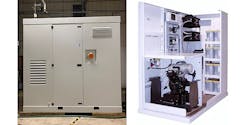Private LTE (PLTE) communications are a recent innovation that allow organizations to use cell tower communications technologies as an alternative to Wi-Fi networks. Both faster, more secure and far more scalable, businesses of all kinds (especially manufacturers) are exploring PLTE for critical business automation and communications needs. Such PLTE networks are ideal for in-house communications (actual cell towers are optional), and many organizations are evaluating this promising technology. One electric utility, Ameren Illinois, is implementing a PLTE network to manage its power distribution facilities.
But what would happen to your PLTE network during ongoing electric grid outages? How long would it continue to function without an independent power source? What effect would that have on your operations and profitability?
Grid Reliability. According to the Wall Street Journal, America’s power grid is becoming more unreliable. “The U.S. power system is faltering just as millions of Americans are becoming more dependent on it—not just to light their homes, but increasingly to work remotely, charge their phones and cars, and cook their food—as more modern conveniences become electrified.”
Recently, Utility Dive reported Federal Energy Regulatory Commission commissioners testified before the Senate Energy and Natural Resources Committee about how the grid faces major reliability challenges. The cost of utility-provided power is also rapidly increasing. For example, Massachusetts utilities recently announced a 64% jump in their rates. Expect that trend to continue.
Last year Reuters disclosed some very disturbing news. Vast swaths of cellular communications nodes in the EU can go dark within 30 minutes of power outages. In Germany, Deutsche Telecom has an estimated 33,000 cell towers. France has about 62,000.
This is because they only have battery back-up systems designed to provide power for short periods of electricity outages. EU power companies recently were planning rolling blackouts of two hours or more. Prospects for Winter 2023-2024 are just as dim. Despite desperate pleas to their respective governments, cellular operators cannot be assured of continued electric supply.
The PLTE community has an opportunity to avoid the imminent dangers being faced by our friends in Europe. Still in its formative stages, PLTE can adapt to minimize potential power disruptions.
Power Requirements. The combination of rising power consumption and increasing electricity costs have raised concerns among cellular and PLTE operators. Newer-generation technologies, such as 5G, require significantly more power than before. Some estimates see 3 to 4 times as much power required, depending on the base station configuration. A typical 5G base station may need at least 15,000 watts of power to operate. Efforts to incorporate edge devices into the network will further increase the power requirements. Power for your PLTE network must be available 24x7, regardless of weather conditions or grid power disruptions.
As in Europe, most PLTE network nodes use grid-supplied power for normal operations. Some have back-up power systems, like battery storage, solar, wind and diesel generators. Most communication sites have back-up power for only a few hours or days, and then it’s lights out.
Most back-up power generation systems today are intended for intermittent, emergency use. What is needed are generators that are designed for long endurance and minimum maintenance. Generators that are affordable, take up little space, and can be secured on site. A highly reliable power supply that can work with, or without, utility-supplied power.A New Approach. I suggest using utility-supplied power, but differently: Remain connected to the grid, but rely primarily on power that you generate. Perfectly legal; just don’t sell it to others. If you have issues with your own generation assets, utility power is automatically sourced until you resume generation. The grid becomes your back-up power source.
Generate your own power continuously, to offset utility power costs and improve resilience. Rising electric utility bills are reduced drastically. In the event of grid-down conditions, your operations are not affected because your primary power source is your own generator equipment.
On-site generating systems can be perfectly sized for the requirements of a PLTE site, and are proven technology, deployed for many years in thousands of locations. They are designed to run continuously, for 10 years or more, with a maintenance intervals every six months (4,000 hours.) They will operate on natural gas, propane or renewable biogas, and can switch between these. Extremely low emissions meet and exceed the most stringent emissions standards.
Installing your own power generation equipment can greatly improve the resilience of your vital PLTE networks and lower operational costs. And the ROI is very compelling. Once the capital expense is paid, the generation equipment will help a manufacturer avoid electric utility costs for many years. Savings are even greater if you can make use of the heat created by the generator’s engines.
But most important, incorporating such independent power generation will increase the reliability of your network. Europe may soon demonstrate the importance of having an independent power system to operate cellular communications systems. With onsite power generation you can keep your PLTE networks from going dark.
Brian Reinke is president of TDI Energy Solutions, which offers customized lifecycle cost analysis for metalcasting operations’ energy needs. Contact him at [email protected]










